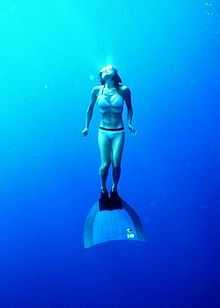Haenyeo
| Haenyeo | |
| Hangul | 해녀 |
|---|---|
| Hanja | 海女 |
| Revised Romanization | Haenyeo |
| McCune–Reischauer | Haenyŏ |
The haenyeo, literally meaning "sea women", are female divers in the Korean province of Jeju. They are representative of the matriarchal family structure of Jeju.
History of haenyeo
The term Jam-Nyo (diving women) was first used in the 17th Century.[1] A large migration of these women to the mainland in 1887 and Japan in 1903 has been documented that shows a large growth in their productivity.[1]
In the 17th century, many men went to sea to fish or row warships, and offshore diving largely became women’s work.[2] It could also be said that women simply were more adapted for the job, with their bodies keeping them warmer and being more suited to swimming than a male, with more body fat. With that, they often became "the head" of their family. On Mara Island, where sea products accounted for almost all sources of revenue before it became increasingly attractive as a tourist site, gender roles were entirely reversed. Often men would look after the children and go shopping while the women would bring in money for the family.
This evolution clashed with Korea's Confucian culture, in which women have traditionally been treated as inferior. As a result, administrators from Seoul (unsuccessfully) tried to bar the women from diving, ostensibly because they exposed bare skin while at sea.
Starting from the late 1970s, exports of sea products to Japan such as abalone and conch have made the sea women richer than ever, allowing them to fix their houses, build new ones in Jeju City and send their daughters to college. However, there is a threat to the haenyo's continued success: with their daughters choosing to work in the island's tourism industry or in the big cities, the haenyo will most likely disappear. While in 1950 there were as many as 30,000 haenyo on the island, in 2003 there were only 5,650 sea women registered as divers, of whom 85% were over 50 years old. In the early 1960s, 21% of women on the island were free divers, providing 60% of the island's fisheries revenue.[2] With the number of sea women declining and with tourism giving Jeju men more opportunities, it is unclear what will happen to their daughters' status in their communities and home, though it is unlikely that the matriarchal family structures will continue to survive. As of 2014 only about 4,500 haenyeo, most aged over 60, were still actively working.[2]
In 2014, South Korea applied to UNESCO to add the haenyo to its Intangible Cultural Heritage List.[2]
Diving pattern
The haenyeo begin shallow water diving as early as age eleven and move on to deepwater diving by age eighteen.[1] They have been observed diving as long as 65 years of age.[1]
Time in the water varies by season, from as little as 20 minutes during the winter to as long as 95 minutes in the summer.[1] Dives have been observed to last approximately one minute, with 30 seconds spent on the surface between dives.[1] Routine diving occurs in shallow water, but deeper excursions, to 15 or even 20 meters, have been observed.[1]
The divers must also contend with other dangers such as jellyfish, and sharks.[3]
Haenyeo in contemporary culture
My Mother, the Mermaid, a 2004 film about a mother (who used to be a haenyeo) and her daughter.
Tamra, the Island, a 2009 television series set in the 17th century, in which the heroine is a haenyo.
Swallow the Sun, a 2009 television series in which the protagonist's mother is a haenyeo.
Haenyeo: Women of the Sea, a 2013 short film about Chewar Park, a still active 82-year-old Haenyeo diver. Examining her daily routine as well as her past, Park sheds light on this unique matriarchal culture that has changed little since the 19th century.[4][5][6]
| Wikimedia Commons has media related to Haenyeo. |
Gallery
-

Haenyo carrying with baskets toward the sea in Ulsan
-

After emerging from the sea, haenyo selling her gathered seafood to people on the coast of Jeju.
-

The display shows haenyo in the past at a museum in Jeju
-

The display shows Haenyo resting at a fireplace after finishing their work in a day.
-

The traditional outfit and tools for haenyo displayed at a museum in Jeju.
See also
- Ama divers in Japan
- Culture+Travel magazine feature about the haenyo of Jeju-do
- Korean culture
- List of Korea-related topics
References
- ↑ 1.0 1.1 1.2 1.3 1.4 1.5 1.6 Hong, SK (1965). "Hae-nyo, the diving women of Korea". In: Rahn, H; Yokoyama, T (eds) Physiology of Breath-Hold Diving and the Ama of Japan. (United States: National Academy of Sciences - National Research Council): 99-112. ISBN 0-309-01341-0. Retrieved 2013-10-06.
- ↑ 2.0 2.1 2.2 2.3 Choe Sang-Hun (29 March 2014). "Hardy Divers in Korea Strait, 'Sea Women' Are Dwindling". New York Times. Retrieved 31 March 2014.
- ↑ "Haenyeo, Female Divers". Chejudo Tourist Association. 1997. Retrieved 2013-10-06.
- ↑ HaenyeoFilm.com
- ↑ HaenyeoDocumentary.com
- ↑ IMDB Page
| |||||||||||||||||||||||||||||||||||||||||||||
